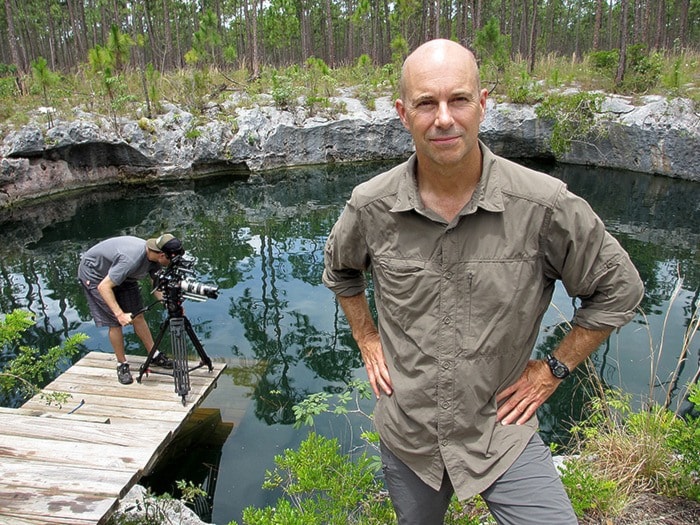It may be called Bahama Blue, but a new nature series currently shooting on location has its home office right here beside Semiahmoo Bay.
The show is the latest venture for award-winning Canadian indie documentary producers Ian Herring and Maija Leivo of White Rock-based Parallax Film Productions – their current bid to counter the “dumbing down” effect of other so-called reality TV.
Fresh from the success of the medieval history-oriented Battle Castle – a television and convergent media project that was nominated for the 2013 Canadian Screen Awards and picked up four Leo Awards, including best documentary series – the Parallax producers are focusing their cameras underwater for their new show.
The six-part series investigates the incredibly rich and varied flora and fauna beneath the waves of the Bahamas – one of the most intense, and fierce, natural habitats in the world.
The beauty and fascination of marine mammals such as dolphins and sharks play a key role, but so, too, does an underwater landscape that encompasses everything from mangroves, deep blue water and sand flats to coral, caves and blue holes.
Bahama Blue is not just another nature documentary, the production team emphasizes.
Parallax’s approach to shooting it, under the personal supervision of Herring, is to document the sea life with the most up-to-date technology and the most lightweight HD, 3D and 4K cameras – capturing natural history “firsts” with unprecedented closeness, definition and flexibility, while keeping to a minimal “footprint” in terms of power use and disturbance of the environment.

It’s the kind of shooting that would have been impossible even a decade ago, Leivo agreed, talking to the Peace Arch News while producing partner Herring was spending long days shooting footage around the islands of the Bahamas.
“We’re definitely beneficiaries of technological development – we’re not even shooting on tape, we’re shooting on memory cards,” she said.
“You can start downloading cards right away. It’s quick – you don’t have to wait 24 hours to see what you’ve got. When you’re shooting underwater you can’t change settings, you can’t change gear. It’s great to be able to dial in with as much accuracy as possible.
“We’re looking at the footage every night and it’s very satisfying for the guys, because they can see right away what’s working. The cameramen know when they got something, or whether they need to go back and try again,” she added.
Even so, she and Herring and their small six-person crew are aware of the challenges of working with three of the big “Ws” – wildlife, water and weather.
“It’s a little bit like a military operation,” she said, adding that Herring has Blackberry messaging set up constantly. “As long as we have Wi-Fi we’re OK. But some islands are more remote than others. As long as Ian has the ability to communicate, he’s happy.”
Leivo says that the series is definitely a labour of love for Herring, a scuba-diving enthusiast.
But she also took a scuba diving course last fall with Ocean Pro Divers, she said, in part to be able to understand the challenges of shooting the material for the series, which has been in development for two and a half years.
“When you’re working on something like this, it has to be something you’re sure about and passionate about – that’s what’s going to sustain you through the dark nights of the soul,” she said.
Turning point for the Bahama Blue project was securing a major partner – Canada’s Oasis, a Blue Ant Media Channel – which will debut the series in early 2015.
Through deals arranged by London-based factual content distributor TVF, Parallax has since been able to license the series to Discovery Network International territories including Latin America, Asia, Italy and CEMEA (Central Europe, the Middle East and Africa) – as a documentary without reliance on “talking heads” it lends itself to dubbing and repackaging for different markets.
Leivo said that she and Herring shot pilot footage with the aim of pitching the project to Oasis executive vice-president Vanessa Case, with whom they had worked previously when she was at National Geographic’s Canadian channel.
“She took one look at what we had and said ‘that – we want that!’” Leivo laughed.
Being able to deliver startling underwater footage in 3D and in 4K – four times the detail of standard HD – was also a selling point for the high definition channel, she said.
Focusing exclusively on the Bahamas for the current series was also a practical decision, she explained, meaning that the production could access a single base of local wildlife experts as well as the same governmental authorities, without having to reinvent the wheel for each episode.
If the concept is successful, there’s a distinct possibility it could spawn other series, Leivo said.
“There could be a Belize Blue, a Barrier Blue, a Hawaii Blue,” she said.
But the Bahamas offers plenty of scope for now, she added.
“There are some seven or eight hundred islands in the Bahamas, each with its own ecosystem,” Leivo said.
Viewers may not be aware of the ecological progress in the area, she added.
“The Bahamas is in the forefront of shark saving and preservation – there’s been a full ban on the shark catch since 2011, and they’ve set up protected areas.
“Sharks are worth more to them alive than dead – rather than getting $50 for a shark fin, they’ve found sharks can capture tourist business.”
